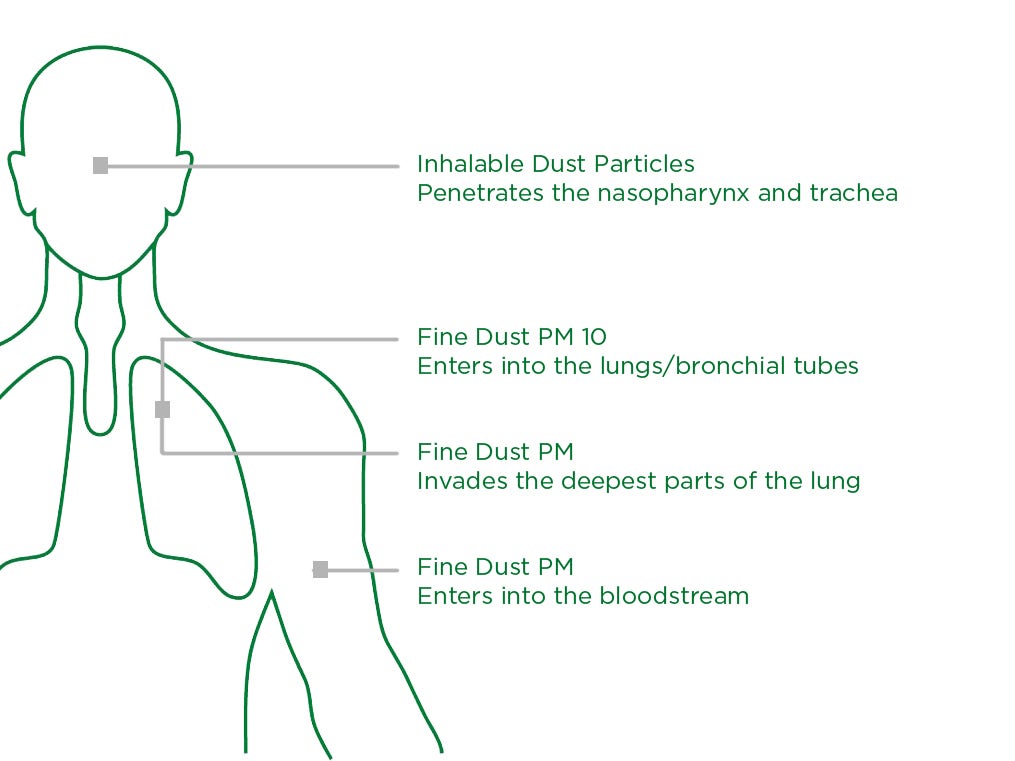Fine dust particles & air pollution: Filtration for clean air
Why should it affect your filter selection?
If you’ve ever looked closely at the stones on a pebbly beach, you’ll know that nature doesn’t do uniform. Pebbles come in an almost infinite array of sizes, shapes and colour—all impacted by the world around them. Scale this down to microscopic dimensions and the same is true for the air we breathe. It’s a cocktail of different particles and gases, both natural and manmade.

Particulate matters
A major ingredient in this cocktail is PM (aka particulate matter). PM is solid or liquid matter suspended in the air around us and is typically categorised according to its diameter. PM10 is particulate matter under 10 µm; PM2.5 is under 2.5 µm across; and PM1 is—unsurprisingly—smaller than 1 µm.
Understanding the difference between these PM categories is important as they all have a varying level of impact on our health. Particles around 100 µm across are prevented from entering our bodies by our nasal hair. But smaller particles go further. PM10 is trapped in our throat; PM2.5 is caught in the lungs; and PM1 can get past everything to enter the bloodstream. It’s these smaller particles that can really have an adverse effect on our health.
And the list of health complaints associated with PM is growing almost continually. PM has been linked with various lung diseases, heart attacks and is classified as a class 1 carcinogen. Little wonder the World Health Organization ranks air pollution as the greatest environmental risk to human health—accounting for seven million deaths a year1.
What this means for filtration
So the PM in the air around us is a big threat to our health. And that’s why air filters are important. Our bodies have in-built defences to protect against particles bigger than PM10, but when it comes to particulate smaller than this, it’s the job of air filters to protect our health.
But PM is far from uniform—both on a local and wider level. And that poses a challenge when it comes to air filtration. The current standard for testing the performance of an air filter uses just one particle size—0.4 µm. But as we have seen, this doesn’t reflect the true conditions in which the filter will be expected to operate. Filters have to contend with particles ranging from 10 µm in diameter all the way down to submicron level. Using one particle size is the equivalent to testing fishing equipment on salmon and then expecting to use it to catch a 400 kg blue marlin. It might just about catch it, but it’s not going to be the most efficient way of doing so.
And that’s one of the main reasons that a new standard for classifying air filters will soon be with us. ISO 16890 tests a filter’s performance across a number of different particle sizes—from 0.3 µm up to 10 µm—to give a more accurate indication of how it will perform once it’s installed in an air handling unit. ISO 16890 then categorises a filter according to its performance at three particle sizes within this range—namely PM10, PM2.5 and PM1.
That means when it comes to choosing a filter, it will be easier to select a product that’s suited to your application. So if your air intake has to contend with beach sand or pollen, a filter with a good PM10 rating will perform best. But if you need to remove industrial fumes or metal dust from your incoming air, look for a product that is highly rated for PM2.5 or PM1.
Essentially, ISO 16890 makes it easier to see how your filter will perform in real life. So it’s good news for you, and the people in your building.
1 World Health Organization, Burden of disease from the joint effects of Household and Ambient Air Pollution for 2012, 2014.
Contact us
At MANN+HUMMEL, we’re here to support your air filtration needs! Whether you have questions about our products or need tailored solutions, our expert team is ready to assist you. Reach out to us via email, telephone or contact form to discuss your requirements, and let’s work together to enhance your air quality. Contact us today and experience exceptional service tailored to your business!